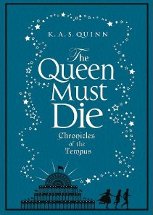The Queen must die by K.A.S. Quinn

Atlantic Books, 2010. ISBN: 978 1848873704
(Suggested reading level 12-15) First in The Chronicles of the
Tempus
trilogy.
In this novel, Katie Berger-Jones-Burg, a contemporary American
teenager, time travels to London in 1851 where she becomes embroiled in
a sinister plot to assassinate Queen Victoria. Time slips are
acceptable in making historical fiction meaningful and alive,
especially when witnessed and interpreted by people whose language and
life experience is familiar to the reader's. I found the start of the
story tedious however, as the author introduces Katie's dysfunctional
rock star mother and paints the picture of a girl who feels lonely,
perhaps even unwanted as her mother meets a series of unsuitable men
with whom she conducts brief and unfulfilling relationships. The reader
is also made aware that Katie has visions of tormented figures,
strangely dressed, whom she instinctively understands are from an
earlier century. This is uninspiring and clumsy. Katie escapes into her
private world of literature, reading widely and eclectically and it is
whilst she reads a published series of letters written by Princess
Alice, one of Queen Victoria's six daughters that she falls asleep and
awakens in Alice's bedroom. Making friends with Alice and James, the
son of the Royal Doctor, Katie learns that a movement is afoot to
murder the Queen and the trio investigates, skulking about the Palace's
labyrinth of secret chambers and corridors whilst following intruders
in the dead of night. Fantasy elements aside, the story is laughably
implausible, given the confines of regal households of the time and the
most ungainly conversations and thought monologues occur as the author
awkwardly attempts to inform the reader and develop the plot. As the
characters seek to understand how and why Katie time traveled, whilst
attempting to keep her presence secret, a major feature of the story in
the construction of the Crystal Palace for the 1851 London Exhibition
is introduced. This is genuinely interesting and educational yet I felt
that the story could have been so much more appealing had the author
explained the Royal genealogy and details of national history earlier
and more clearly. At the conclusion, I was left thinking that the
author had a justifiable fascination with this period but assumed
readers were similarly informed. Whilst much of this novel is
excruciating to the adult reader, hopefully teenagers will be
captivated by the fantasy, mystery and action so that they are unaware
of the various flaws.
Rob Welsh